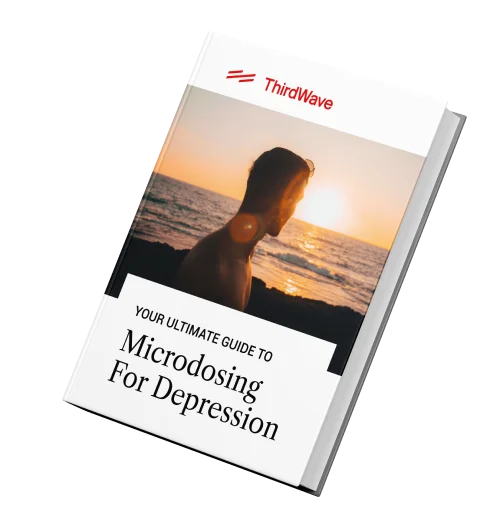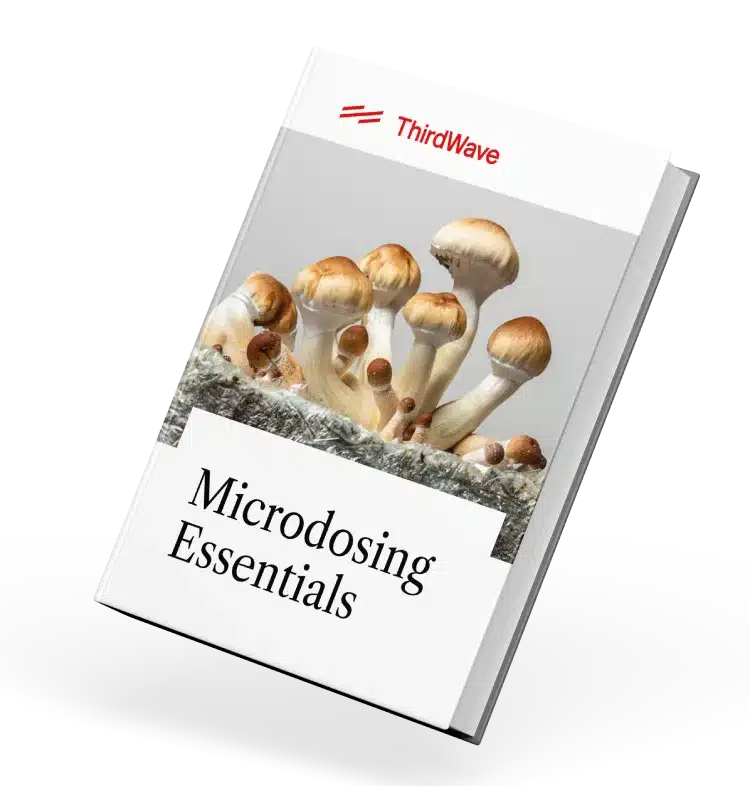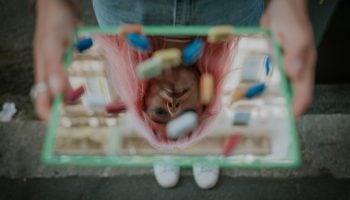The Ultimate Guide to
Kambo
(Kampo, Sapo, Vacina do sapo, Medicina da floresta, Frog medicine)
Kambo is a potentially harmful substance, and we do not encourage or condone the use of this substance. However, we believe that offering responsible harm reduction information is imperative to keeping people safe. For that reason, this guide is designed to ensure the safety of those who decide to use the substance.
Overview
01What is Kambo?
Kambo, also known as frog medicine, is the venomous secretion of Phyllomedusa bicolor (the giant leaf or monkey frog), a bright green tree frog native to the Amazon basin. It can be found in the Amazon rainforests of South America in the regions of northern Brazil, eastern Peru, southeastern Colombia, and parts of Venezuela, Bolivia, and the Guianas. In many regions outside Brazil, both the frog and its secretion are known as sapo (or ‘toad’).
Giant monkey frogs have a distinctive “song” that can be followed to collect them at night. Captive specimens are tied by the legs stressed to induce the secretion: a waxy substance scraped onto wooden splinters from the back and legs of the frog. Once dried, kambo can be stored for upwards of a year without losing its potency. For use, it’s mixed with saliva or water and directly applied to specially made skin burns.
As the popularity of kambo has grown, so has concern over how these harvesting methods will affect the species. While the frogs are not killed when the secretions are harvested and the giant monkey frog population is currently listed as stable, this practice has come under scrutiny for how the animals are treated.
Kambo has a range of traditional and potential therapeutic applications, both medical and psycho-spiritual. Commonly described as an ‘ordeal medicine’, the frog secretion is known for its powerful emetic or purgative effects. Despite its initial unpleasantness, kambo is widely sought out to revitalize body and mind.
Effects
02The Kambo Ceremony
The word “Kambo” often refers to both the substance and the ceremony. The two are fundamentally linked, and each provides the context and purpose for the other. To understand Kambo, one must understand the Kambo ceremony.
Some substances deliver euphoria. They make you laugh; they make you see things. People bring them along on hikes, to concerts, to parties, and let them run their course in all sorts of different environments.
Kambo is no such substance. Kambo is frog poison, and it makes you feel uncomfortable. People don’t take Kambo to have fun, but to purge, cleanse, and heal themselves.
The Kambo ceremony accounts for the discomfort and is structured to provide a safe setting for a challenging experience. People participate in Kambo knowing what awaits. There are no distractions from the experience because, with Kambo, there shouldn’t be. It’s a common saying that Kambo gives you what you need, but not what you want. In this sense, Kambo is both frog poison and frog medicine.
A Brief Note on Ethical Practices
There’s a growing concern surrounding the ethics and sustainability of harvesting and exporting Kambo from giant monkey frogs. As detailed below in the section on sustainability, many Kambo alternatives are available and readily accessible to those not residing in areas where the frog populations are found.
If you still absolutely feel the call to use Kambo, we recommend finding a center in an area where the giant monkey frog resides naturally and putting in the effort to ensure that the Kambo used is sourced ethically and sustainably.
Some harvesting practices require the frog’s limbs to be tied while the animal is subjected to stressful stimuli to induce secretion. Others say the frog will only secrete its venom if the practitioner has good intentions. Whatever your beliefs, be aware of the methods and practices that go into your Kambo experience.
How to Prepare for a Kambo Ceremony
Preparations are useful for any potentially transformative, substance-induced experience. When taking Kambo, they are necessary. Mostly these preparations relate to the purging and cleansing that occurs during the ceremony.
The cleansing process begins before the actual ceremony. Most Kambo practitioners recommend fasting for 10-12 hours before use. Recreational drugs and alcohol are also prohibited for at least 24 hours prior. Finally, those taking Kambo should aim to drink at least 1-2 liters of water before the ceremony. These steps make the eventual purging easier.
Kambo Preparation
To prepare Kambo, the dried resin is combined with a little water or saliva to form a paste-like “green mustard.”[3][11] It is then divided into dots for application.[20] Small points (roughly 1/8” in diameter) are burned through the top layer of the skin with a smoldering piece of titica vine (Heteropsis flexuosa)[11][24], a twig[3], or an incense stick.[25] Once the skin has been removed from the burns—as painlessly as from a blister—the Kambo dots are applied. Aided by Kambo’s vaso dilating peptides and pro-inflammatory agents[8], they are absorbed into the bloodstream within seconds.
Usually, a large quantity of liquid is consumed beforehand—for example, two liters of water[11], 3-5 liters of fermented corn caiçuma[1][4], a manioc or banana gruel[6], or diluted papaya juice.[4] However, due to the health risks of hyponatremia, we would not recommend drinking large quantities of liquid in a short space of time.
According to Peter Gorman, the normal dosage is roughly 10 mg of Kambo for each point, up to a maximum of 100 mg per day.[8] The number of points varies depending on body size, experience, reasons for application, and sometimes the practitioner’s tradition.[1][20] While five points appears to be common[4], considerably more or less may be required.[26]
The Kambo Ceremony and Experience
Group Kambo ceremonies usually have 10 or fewer participants. Apart from the practitioner, there may also be assistants. The assistants have multiple roles to play. They might bring out buckets when someone is ready to purge or escort someone who needs to go to the restroom. Sometimes, they may merely act as a calm and supportive presence.
The practitioner applies the Kambo to participants, using small burns made on the skin. Also known as “gates,” these burns allow the pasty substance to enter the bloodstream quickly. These gates can leave scars, though they can fade with time and care. Practitioners sometimes also apply oils and balms to reduce scarring after the ceremony.
Often, a test point will be used first to determine if the participant experiences any adverse effects. Once it is deemed safe for use, the shaman or practitioner will begin the application. Practitioners measure Kambo in “points,” and anywhere from 2 to 10 points may be applied.
What to Expect
The immediate effects of Kambo medicine are intense and unpleasant but short-lived, usually lasting no more than 30-40 minutes.[20] They include a feverish rise in temperature, sweating, shivers, and dizziness as the heart rate becomes rapid—possibly reaching more than 190 beats per minute.[23] The blood pressure may rise or fall dramatically, accompanied by increased awareness of the veins and arteries. Many people report a tingling or burning sensation like electricity that starts from the points and spreads through the body. Some may also feel a dissociative or drunken high.[27][28]
Overwhelming nausea is generally unavoidable with Kambo and purging is likely—either by vomiting, defecation, or both. Other effects include a feeling of pressure in the head, neck, and torso, stomach pain, inflammation of the throat, dry mouth, blurred vision (or temporary blindness), difficulty moving, and numb, swollen lips and tongue. This is the body’s physical reaction to acute poisoning.
After these initial biological effects have worn off and the heart rate has returned to normal, it may be necessary to rest. Some fall into a dreamless sleep, while others make strange animal noises.[6][8]
Your experience may feel enhanced following the Kambo purge.[3] You may feel great physical strength, sharpened senses, and heightened mental alertness. Desirable after-effects like these may take a day to materialize or they could be immediate. They also tend to include a consistently elevated mood, increased physical and mental energy, decreased stress, and enhanced focus.
Precautions
Kambo is best taken on an empty stomach, bladder, and bowels. It’s advisable to avoid solid food, and especially salt[1], for 8-10 hours beforehand. Alcohol should also be avoided for 24-48 hours before application.[29]
It’s a good idea to test a small amount of Kambo on the skin before administering it to burns.[29] Many practitioners wait up to a day to gauge negative reactions. It is highly advised not to try this on your own, but to find an experienced Kambo-giver or guide, due to the possibility of adverse effects or medical contraindications that could have severe or fatal consequences. At the bare minimum, if self-administering Kambo, a sitter is necessary. Also, keep in mind that Kambo could be habit-forming. 12 applications per year is a good upper limit.[30]
Personal Growth
03Panema—an Arawak term used by the Ashaninka and others—describes a negative energy that gathers over time.[1][2] Traditionally visualized as a kind of dense grey cloud or aura[47], panema is blamed for bad luck, depression, laziness, irritation, and other adverse states. Naturally, clearing this cloud is vital for indigenous groups that depend on hunting and community coherence. For many, kambo serves this purpose.
Outside of traditional contexts, the dissipation of panema is framed in terms of “clearing the pain body,” “realigning the chakras,” or reorganizing personal psychology.[46][47] The purge itself may be felt as an expulsion of bad thoughts, habits, negative personality traits, or persistent life problems.
A profoundly transformational tool, kambo medicine is known to increase compassion, courage, emotional stability, and personal sovereignty.[48] Some users feel more “real” or “solid” after kambo application—less in their heads and more in their bodies. Frustration, anger, and anxiety also tend to reduce or dissipate entirely. These positive changes may last several days or several months, depending on the application and the person receiving it.[26]
Kambo may also help to overcome a fear of dying. According to one practitioner, terminally ill patients have claimed to see “the other side” during their experience, returning with a newfound serenity about death.[11]
Considering a Kambo experience for personal growth? If you decide to sit with this medicine, be sure to look for Kambo retreat centers dedicated to ethical sourcing and sustainability.
Therapeutic Use
04Dermaseptins, including adenoregulin, are powerful antibiotics.[33][34][35][36] Found to be rapidly and irreversibly effective against a range of parasitic microorganisms, they’re also entirely non-toxic to mammalian cells.[13] Combined with their ability to cross the blood-brain barrier, peptides in kambo are especially promising for conditions like Cryptococcal meningitis in patients with late-stage HIV.[37] Among the pathogens killed by dermaseptin B2 are the filamentous fungi that opportunistically infect AIDS patients.[38] With the emergence and spread of highly resistant pathogenic bacteria, novel antibiotics such as these are becoming critical.
Since adenoregulin affects the binding of agonists to adenosine receptors—instrumental in the permeability of the blood-brain barrier[39]—it may be useful in the development of treatments for Alzheimer’s disease, depression, and strokes.[3] Anecdotal evidence supports kambo’s use in depression treatment, anxiety, and addiction.[30][40][11]
Are you curious about journeying with kambo to heal from mental illness? Visit Third Wave’s psychedelic directory to find an ethical kambo retreat center that offers sustainably sourced medicine.
There’s also compelling anecdotal evidence for kambo’s effectiveness in the treatment of chronic fatigue syndrome (CFS). According to one sufferer, the secretion completely eliminates CFS symptoms when taken regularly.[41]
The deltorphins and dermorphin present in kambo have analgesic effects comparable to the body’s own pain response of beta-endorphin release.[3][8] They’re also stronger than morphine without the same level of respiratory depression[42], tolerance potential, and withdrawal symptoms.
Phyllokinin may be useful in the treatment of hypertension, having been shown to lower blood pressure more effectively than other polypeptides.[43]
Other conditions that may benefit from kambo include chronic pain[44], Parkinson’s disease, vascular problems, hepatitis, diabetes, rheumatism, and arthritis.[20]
Are you curious about journeying with kambo to heal from mental illness? Visit Third Wave’s psychedelic directory to find an ethical kambo retreat center that offers sustainably sourced medicine.
Legality
05Learn about safe, legal, and sustainable Kambo retreat centers from Third Wave’s psychedelic support directory.
Pharmacology
06Receptor binding
Phyllocaerulein is a hypotensive neuropeptide[14] that stimulates the adrenal cortex and pituitary gland. Present in kambo at around 32 micrograms per milligram, it has a role in the medicine’s analgesic and satiety effects.[8]
Phyllomedusin interacts with tachykinin receptors—shown to regulate the functions of dopamine, serotonin, and other neurotransmitters[15]—while phyllokinin targets the bradykinin receptors. Phyllomedusin contracts smooth muscles while phyllokinin relaxes them. Both are potent vasodilators, increasing the permeability of the blood-brain barrier.[14] They are present in kambo at around 22 and 18 micrograms per milligram, respectively.[8]
Sauvagine, present at 3 micrograms per milligram, functions like a hormone.[8] It interacts with the pituitary-adrenal axis and corticotropin-releasing receptors—involved in stress, anxiety, depression, and addictive behavior.[16][8]
Adenoregulin stimulates the binding of agonists to A1 adenosine receptors and is shown to cause behavioral depression in mice.[7][13]
Deltorphins and dermorphin are both powerful opioid receptor agonists. Deltorphins in particular have among the highest binding affinity and selectivity to delta opioid receptors of any natural compound.[17] Dermorphin is highly selective for mu opioid receptors.[17][18] Present at 5.2 and 0.25-0.33 micrograms per milligram[8], respectively, these peptides are many times more potent than endogenous beta-endorphin.[19]
Safety and Toxicity
Little is known about the long-term safety of kambo and the potential health risks, but evidence suggests that deltorphin and dermorphin may cause respiratory depression and lead to heavy reliance with frequent use. Kambo-related deaths have also been linked to the secretion’s depressive effects on the central nervous system. Toxins present in kambo may affect the cardiovascular system, kidneys, pancreas, and liver. In one case, it led to toxic hepatitis caused by the frog secretions.[19]
The International Association of Kambo Practitioners (IAKP) insists that sudden death is rare and almost always attributable to some pre-existing condition. Common contraindications include hyper- or hypotension, brain hemorrhage, aneurysm or blood clots, Addison’s disease, epilepsy, heart problems, and pregnancy.[11][20][9]
Anecdotal reports warn of “frog disease,” an incurable condition arising from the non-traditional use of kambo (e.g. oral consumption, smoking, or insufflation).[21] Apparently inducing a feeling of your brain being eaten, “frog disease” is characterized by weak muscles, cardiac arrest, and death.[22] The condition may be caused by parasitic microorganisms—usually eliminated by the body’s immune response to skin burns.[23]
History & Stats
07Brief History of Kambo
Kambo is supposedly named for the legendary pajé (or medicine man) Kampu. This ancestral shaman is said to have learned about the medicine from a forest spirit, having exhausted all other means to heal his sickly tribe. According to the Kaxinawá, the spirit of Kampu lives on in the giant monkey frog, continuing to heal any who seek it. [1]
Whatever the mythical origin, kambo medicine has long been used by indigenous Pano-speaking groups in the Amazon, including the Katukina, Asháninka, Yaminawá, and Matsés (or Mayoruna). It may also have been used by the classical Maya, whose art depicted tree frogs next to mushrooms. [2] Traditional uses include eliminating toxins, increasing strength and stamina, monitoring pregnancy (or inducing abortion), and dispersing negative energy, or panema. [3] In the rainforest, kambo is used within shamanic hunting practices and as an aid, reducing the need for food and water and minimizing the human scent. Fortified by the “vaccine,” hunters are also thought to emit a strange green light that draws their prey near. [4]
The first Westerner to witness kambo use in the Amazon was the French missionary Constantin Tastevin, who stayed with the Kaxinawá in 1925. According to his informants, the kambo ritual of self-envenomation originated with the neighboring Yaminawá. [5]
Kambo was rediscovered in the 1980s by journalist Peter Gorman [3] and anthropologist Katharine Milton [6]—both of whom spent time living with the Matsés/Mayoruna of northeastern Peru/southwestern Brazil. They each supplied kambo samples to the biochemists John Daly [7] and Vittorio Erspamer [8], who analyzed the secretion’s peptide content and saw great medical potential. Pharmaceutical companies have made efforts to synthesize and patent kambo peptides, but have largely struggled to develop medications. [9][10]
Until 1994, kambo was rarely applied to non-Indians. It was first offered as a therapy by Francisco Gomes, a half-Katukina caboclo living in São Paulo. From around 1999, he was joined by Santo Daime practitioner and acupuncturist Sonia Maria Valença Menezes [11] and other non-Indian kambo applicators, including holistic therapists, doctors, and members of the União do Vegetal religion. [2]
In 2004, the Brazilian government prohibited all advertising of kambo’s medical or therapeutic benefits, effectively shutting down the new urban applicators. In part, this was a legal response to the Katukina’s demand to protect their ‘intellectual property’. [4][10]
Current use
International awareness of kambo therapy continues to grow, having spiked around the mid-2000s.[2] Today, Western-trained applicators hold kambo ceremonies around the world[12] and kambo sticks can be purchased online.
There’s some concern within the kambo community that commercial supply chains might exploit indigenous tribes. Bulk production of kambo sticks could also pose a threat to P. bicolor populations in the wild.
Ethical Considerations
08Kambo and the Sustainability of the Giant Leaf Frog
The giant leaf frog population is currently listed as stable,[60] but the explosion in kambo’s popularity increases future risk for the species. With the increase in demand, some locals are incentivized to capture and sell the frogs, removing them from their original habitat and putting pressure on an ecologically sensitive species. And while “Kambo sticks” can be purchased online, it’s often difficult to be sure of the source origin and how it was procured.
Furthermore, methods of inducing secretions can be stressful to the frogs, which could have adverse effects on their survival. The animals are typically restrained by tying their limbs and spreading them out in an X shape while secretions are scraped off their skin. Methods of inducing venom exposure so the secretion can be harvested involve exposing the frog to an open flame or physical, non-lethal blunt trauma.[61]
While other, less invasive methods can be used to harvest their venom, the frogs do undergo some level of stress and trauma prior to being released. Some practitioners, on the other hand, argue that the frog only provides venom when the person harvesting it has good intentions, but this is debated in the community. Regardless, scaling up venom harvesting practices to meet demand will only increase population-wide stressors on the species and it’s unclear how well they can cope.
Cultural Appropriation of Kambo
Kambo has been used by indigenous peoples in the Amazon for possibly thousands of years. Small scale, local use in areas where few alternatives exist can be defended from both a practical and ethical viewpoint. But with the surge in demand all over the world, some have criticized use outside of these contexts as cultural appropriation.
For example, it’s become somewhat of a badge of honor in online communities to post images of skin burn marks after using kambo. While these users might genuinely be seeking the healing properties of kambo, this practice is considered to be far removed from the original context of the medicine’s purpose.
Most westerners have access to more sustainable and less culturally sensitive alternatives for many ailments. Here are just few examples:
- Psilocybin and ketamine have shown remarkable promise in treating depression.
- Ayahuasca and ibogaine have proved effective in treating alcoholism and many other addictions.
- Cannabis, CBD, kratom, ketamine, and even microdoses of LSD can be used to help manage pain.
- Many plant sources are available for emetic and purgative purposes as well (such as ayahuasca)
Myths
09“Kambo is hallucinogenic”
P. bicolor is occasionally referred to as an “hallucinogenic tree frog”,[27] with some users reporting visions of varying intensity.[3][28] However, none of the peptides present in kambo are known to produce these effects. Hallucinations are far more likely due to other, psychoactive substances that are commonly taken with kambo, such as nu-nu snuff.[8][20]
FAQ
10Can it be detected in a drug test?
Peptides are notoriously difficult to test for.[50] Dermorphin, known for postoperative pain, for instance, which has become an illicit performance enhancer for racehorses, can only be detected by specialist labs.[51] Although kambo contains opioid receptor agonists, it doesn’t contain any opiates. It is therefore extremely unlikely to be detected in a drug test.
Can kambo cause psychological trauma?
The unpleasant effects of kambo can feel endless for those experiencing them. There may also be a feeling of drunkenness or dissociation. For the most part, however, kambo is not psychoactive.
Are there risks?
Kambo is relatively safe when properly applied to healthy individuals. However, it is likely unsafe for children, pregnant or breastfeeding women, people with heart problems, and patients either recovering from surgery or taking immuno-suppressants for organ transplant. It should also be avoided by chemo- and radiotherapy patients, including those planning to start treatment within four weeks. For more information, see Pharmacology.
Will it leave scars?
Yes—although kambo scars fade over time, they won’t disappear completely. Aftercare balms such as sangre de drago may help to improve their appearance. Alternatively, the same points can be used within 2-3 months of the previous application.
Can I keep the frogs at home?
P. bicolor can be kept as pets, but they’re not an amphibian for beginners.[52][53] Captive specimens also don’t appear to secrete the same kind of venom as those in the wild—possibly due to dietary differences.[54][55][56]
What is the safest way to take kambo?
The only safe way to administer kambo appears to be via skin burns, but the specifics tend to vary between practitioners. In the caboclo kambo initiation, for instance, the medicine is traditionally applied at the new moon of three consecutive months—each time increasing in dosage. Kambo may also be double- or triple-dosed within a single session.
Can I use kambo to microdose?
There’s very little information on microdosing with kambo, but some consider it dangerous. Purging (i.e. with large doses) is thought essential for releasing toxins.[23]
Does it produce tolerance?
Frequent users build up a tolerance to kambo. Some Katukina men take more than 100 points at a time.[57] Anecdotal reports suggest that sananga and ibogaine can reverse the tolerance effect.[58]
Can I mix it with other drugs?
Kambo is often used in conjunction with ayahuasca because advance purging helps to optimize absorption. The vasodilating peptides phyllomedusin and phyllokinin also serve to increase the permeability of the blood-brain barrier.[59]
Kambo may also be taken with certain psychoactive snuffs, including nu-nu and rapé, as well as ibogaine.
The safety of combining kambo with other substances is not entirely known, but alcohol should be avoided. It’s also recommended to avoid recreational drugs for at least three days after kambo has been applied.[47]
Footnotes
10[1] Gomes, M. B. (2008). Kambô, The Spirit of the Shaman.
[2] Labate, B. C., de Lima, E. C. (2014). Medical Drug or Shamanic Power Plant: The Uses of Kambô in Brazil. Ponto Urbe, 15.
[3] Gorman, P. (1993). Making Magic. OMNI.
[4] Labate, B. C. (2012). The Shaman Who Turned Into a Frog: a Promise of Patented Medicine. Erowid.
[5] Labate, B. C., Jungaberle, H. (Eds.). (2011). The Internationalization of Ayahuasca. Zürich: LIT Verlag Münster.
[6] Milton, K. (1994). No Pain, No Game. Natural History.
[7] Daly, J. et al. (1992). Frog secretions and hunting magic in the upper Amazon: Identification of peptide that interacts with an adenosine receptor. Pharmacology, 89, 10960-10963.
[8] Erspamer, V. et al. (1993). Pharmacological Studies of ‘Sapo’ from the Frog Phyllomedusa bicolor Skin: A Drug Used by the Peruvian Matses Indians in Shamanic Hunting Practices. Toxicon, 31, 9: 1099-1111.
[9] Lattanzi, G. (nd.). Kambô: Scientific Research and Healing Treatments.
[10] Prada, P. (2006). Poisonous Tree Frog Could Bring Wealth to Tribe in Brazilian Amazon. The New York Times.
[11] Sumpter, L. (2015). Kambô: Nature’s Vaccine For The Mind And Body. Reset.me.
[12] IAKP. Find a Practitioner.
[13] Calderon, L. A., Silva, A. A. E., Ciancaglini, P., Stábeli, R. G. (2010). Antimicrobial peptides from Phyllomedusa frogs: from biomolecular diversity to potential nanotechnologic medical applications. Amino Acids.
[14] Den Brave, P. S., Bruins, E., Bronkhorst, M. W. G. (2014). Phyllomedusa bicolor skin secretion and the Kambô ritual. Journal of Venomous Animals and Toxins including Tropical Diseases, 20.
[15] Douglas, S. D., Leeman, S. E., Barrett, J., Dombrowsky, E., Heyward, C. Y., Remeshwar, P. (2014). Tachykinin receptors, introduction. IUPHAR/BPS Guide to PHARMACOLOGY.
[16] Grammatopoulos, D. K., Chrousos, G. P. (2002). Functional characteristics of CRH receptors and potential clinical applications of CRH-receptor antagonists. Trends in Endocrinology & Metabolism, 13(10), 436-444.
[17] Erspamer, V. et al. (1989). Deltorphins: a family of naturally occurring peptides with high affinity and selectivity for delta opioid binding sites. Proceedings of the National Academy of Sciences of the United States of America, 86(13), 5188-92.
[18] Negri, L., Erspamer, G. F., Severini, C., Potenza, R. L., Melchiorri, P., Erspamer, V. (1992). Dermorphin-related peptides from the skin of Phyllomedusa bicolor and their amidated analogs activate two ,u opioid receptor subtypes that modulate antinociception and catalepsy in the rat. Proceedings of the National Academy of Sciences of the United States of America, 89, 7203-7207.
[19] Joanna, P., Łapiński, T. W. (2017). Toxic hepatitis caused by the excretions of the Phyllomedusa bicolor frog – a case report by the excretions of the Phyllomedusa bicolor frog – a case report. Clinical and Experimental Hepatology, 3(1), 33-34.
[20] IAKP. Kambo Q & A.
[21] Murgency. (2016). Still Alive: An Experience with Phyllomedusa bicolor (Kambo) (ID 103731). Erowid.
[22] Psychedelic Times Staff. (2017). Five Methods to Reduce Overall Risk When Taking Kambo. Psychedelic Times.
[23] Kambo.me. Topic: New ways of Administering Kambo (Other than via Skin Burns).
[24] de Lima, E. C., Labate, B. C. (2012). Kambo: From the Forests of Acre to the Urban Centers. Erowid.
[25] Davis, E. (2010). The Bad Shaman’s Sapo. Erowid.
[26] Kambo Cleanse. Testimonials.
[27] Vice Staff. (2009). Hamilton’s Pharmacopeia: The Sapo Diaries.
[28] Varner-Miller, B. (2014). Frogs Psychedelic Effect in the Amazon. Liberty Voice.
[29] Viva Kambo. Frog medicine.
[30] Daly, M. (2016). The Brits Using Amazonian Frog Poison to Fight Depression and Alcohol Abuse. Vice.
[31] van Zoggel, H. et al. (2012). Antitumor and angiostatic peptides from frog skin secretions. Amino Acids, 42(1), 385-95.
[32] van Zoggel, H. et al. (2012). Antitumor and Angiostatic Activities of the Antimicrobial Peptide Dermaseptin B2. PLoS ONE, 7(9), e44351.
[33] Amiche, M., Ladram, A., Nicolas, P. (2008). A consistent nomenclature of antimicrobial peptides isolated from frogs of the subfamily Phyllomedusinae. Peptides, 29(11), 2074-82.
[34] Amiche, M., Seon, A. A., Wroblewski, H., Nicolas, P. (2000). Isolation of dermatoxin from frog skin, an antibacterial peptide encoded by a novel member of the dermaseptin genes family. European Journal of Biochemistry, 267(14), 4583-92.
[35] Zhou, Y. X., Cao, W., Luo, Q. P., Ma, Y. S., Wang, J. Z., Wei, D. Z. (2005). Production and purification of a novel antibiotic peptide, adenoregulin, from a recombinant Escherichia coli. Biotechnology Letters, 27(10), 725-30.
[36] Zhou, Y., Cao, W., Wang, J., Ma, Y., Wei, D. (2005). Comparison of expression of monomeric and multimeric adenoregulin genes in Escherichia coli and Pichia pastorias. Protein and Peptide Letters, 12(4), 349-55.
[37] Mandal, S. M., Roy, A., Ghosh, A. K., Hazra, T. K., Basak, A., Franco, O. L. (2014). Challenges and future prospects of antibiotic therapy: from peptides to phages utilization. Frontiers in Pharmacology.
[38] Mor, A., Amiche, M., Nicolas, P. (1994). Structure, synthesis, and activity of dermaseptin b, a novel vertebrate defensive peptide from frog skin: relationship with adenoregulin. Biochemistry, 33(21), 6642-50.
[39] Carman, A. J., Mills, J. H., Krenz, A., Kim, D., Bynoe, M. S. (2011). Adenosine receptor signaling modulates permeability of the blood-brain barrier. Journal of Neuroscience, 31(37), 13272-13280.
[40] Psychedelic Times Staff. (2016). How Kambo’s Physical and Spiritual Properties Reduce Pain and Treat Addiction. Psychedelic Times.
[41] Phoenix Rising. From Bedbound to Fit and Able in 14 Days: Effects of the Amazonian Medicine Kambo on a CFS Patient.
[42] Negri, L., Lattanzi, R., Tabacco, F., Melchiorri, P. (1998). Respiratory and cardiovascular eects of the m-opioid receptor agonist [Lys7]dermorphin in awake rats. British Journal of Pharmacology, 124, 345-355.
[43] Anastasi, A., Bertaccini, G., Erspamer, V. (1966). Pharmacological data on phyllokinin (bradykinyl-isoleucyl-tyrosine o-sulphate) and bradykinyl-isoleucyl-tyrosine. British Journal of Pharmacology and Chemotherapy, 27, 479-485.
[44] Shivani Fox. (2011). Kambo – Frog Medicine from the Amazon.
[45] The Holistic Sanctuary. Holistic Drug Rehabs.
[46] Ketler, A. (2016). Kambo: Can Poison from a Frog Fix Your Health Challenges? Collective Evolution.
[47] Annu Tara. What is Kambo?
[48] Thoricatha, W. (2017). Way of the Frog Medicine: Interview with Master Kambo Practitioner Simon Scott. Psychedelic Times.
[49] IAKP. About IAKP.
[50] Yosufzai, R., Horne, B. (2013). Peptides almost impossible to detect in testing. Stuff.
[51] Bogdanich, W., Ruiz, R. R. (2012). Turning to Frogs for Illegal Aid in Horse Races. The New York Times.
[52] Reptile Rapture. Bicolor Waxy Monkey Tree Frog Caresheet.
[53] PetHelpful. (2014). How to Care for the Giant Waxy Monkey Tree Frog.
[54] Kambo.me. Topic: Raising the Phyllomedusa Bicolor.
[55] DMT Nexus. Kambo frog medicine.
[56] KamboCleanse. (2015). A Kambo Frog Sweating Poison.
[57] Kambo.me. Topic: How do the Katukina do so many dots?
[58] Kambo.me. Topic: Kambo tolerance.
[59] Psychedelic Times Staff. (2016). Four Ways Kambo Can Enhance the Effectiveness of Ayahuasca Treatments. Psychedelic Times.
[60] Phyllomedusa bicolor. AmphibiaWeb.org
[61] Kambo: the controversial drug derived from stressed-out frogs. The Guardian.
Get Your FREE Ultimate Guide To Microdosing for Depression.
Sometimes hope comes in micro-doses. This guide will walk you through the process and how to best use the healing potential of psychedelics in a safe, intentional way to heal depression.


Get Your FREE Ultimate Guide To Microdosing for Depression.
Sometimes hope comes in micro-doses. This guide will walk you through the process and how to best use the healing potential of psychedelics in a safe, intentional way to heal depression.



